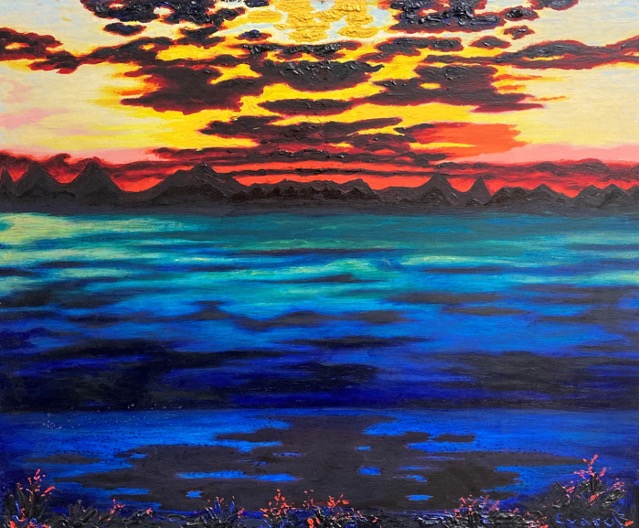Natural landscapes form a central motif in Evard’s work. He not only paints various natural objects but also pays close attention to
The present expressionist work depicts a lake landscape in the foreground with a mountain range in the middle ground and a sky landscape in the background.
The supposed plants located at the bottom edge of the painting make the shore of the lake and the lake itself recognizable. Furthermore, the mountain range encloses the lake. If one were to imagine the painting without the shore plants and without the mountain range, the body of water would probably not be recognizable as such.
The lake is calm; no wave movements are discernible. The sky itself is also calmly depicted; only clouds are visible. This also contributes to the
The powerfully colored sky acts as a counterpart to the equally colorful body of water. While the lake is rendered in
The clouds in the sky and the mountains are rendered in black. This choice of color also contributes to the calming evening atmosphere. Furthermore, the approaching night is
Furthermore, we can observe that the clouds are reflected in the lake, and consequently, we find their blackness mirrored. This reflection of the clouds can be interpreted as a connection between the otherwise seemingly separate lake and sky landscapes. It overcomes the apparent separation and symbolizes the
The sun, as the central object of a sunset and the source of the various colors, is not visible. Only its rays can be discerned.
Horizontal lines dominate the entire painting. Exceptions are the depictions of mountains and plants. They are mostly represented by diagonal, and rarely by vertical, lines. The immediate foreground is not only delineated from its background by vertical lines but also by the impasto, almost relief-like application of paint.
The brushwork here is rather planar than expressive.
As a Swiss, André Evard lived almost his entire life in the Swiss High Jura. In addition to the mountains in the immediate vicinity, not far from his hometown of La Chaux-de-Fonds are Lake Neuchâtel and Lake Biel. Repeatedly, he was inspired by the landscape that shaped him as a young man, leading to various landscape paintings that still fascinate us today.
